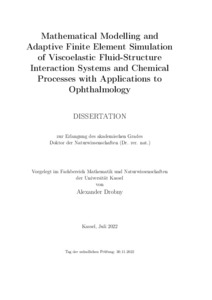Mathematical Modelling and Adaptive Finite Element Simulation of Viscoelastic Fluid-Structure Interaction Systems and Chemical Processes with Applications to Ophthalmology
| dc.date.accessioned | 2023-01-13T14:19:16Z | |
| dc.date.available | 2023-01-13T14:19:16Z | |
| dc.date.issued | 2023 | |
| dc.identifier | doi:10.17170/kobra-202212127217 | |
| dc.identifier.uri | http://hdl.handle.net/123456789/14367 | |
| dc.language.iso | eng | |
| dc.rights | Attribution-NonCommercial-NoDerivatives 4.0 International | * |
| dc.rights.uri | http://creativecommons.org/licenses/by-nc-nd/4.0/ | * |
| dc.subject.ddc | 510 | |
| dc.title | Mathematical Modelling and Adaptive Finite Element Simulation of Viscoelastic Fluid-Structure Interaction Systems and Chemical Processes with Applications to Ophthalmology | eng |
| dc.type | Dissertation | |
| dcterms.abstract | The aim of this thesis is the numerical analysis of nonlinear coupled partial differential equations and their application to ophthalmology. Firstly, we consider fluid-structure interaction problems where the fluid is either Newtonian or viscoelastic. The structure is modelled as a hyperelastic material. The application to ophthalmology lies in the interaction of the vitreous with its surrounding elastic structures like the sclera and the lens. The underlying flow in the vitreous is modelled by a viscoelastic Burgers model or by the Newtonian Navier-Stokes equations depending on the pathology of the eye. Secondly, we consider chemical processes in the context of the treatment of age related macular degeneration which is one of the most common reasons for blindness. We derive a two-compartment model consisting of the vitreous and the retina. The pharmacokinetic and the pharmacodynamic is modelled by a system of convection-diffusion-reaction equations in the vitreous and by a system of diffusion-reaction equations in the retina. Both topics lead to nonlinear partial differential equations in each subdomain with an additional coupling on the common interfaces. To cope with this in the context of viscoelastic fluid-structure interaction we employ the arbitrary Lagrangian Eulerian transformation. The numerical methods are based on the derivation of monolithic variational formulations and the linearization using Newton’s method. The temporal discretization is realized using single-step methods like the Crank-Nicolson scheme. For the spatial discretization we use the finite element method. The numerical methods are analysed on various benchmark problems. Furthermore we apply the dual-weighted residual method to the considered problems and examine its performance when used for adaptive mesh refinement. The results show the superiority of the dual-weighted residual method over global mesh refinement for all considered problems. Additionally the benchmark simulations on viscoelastic fluid-structure interaction show that the viscoelasticity of the fluid significantly influences the drag, the lift and the displacement of the beam and as a results also influences the fluid flow itself through the two-way coupling of the structure and the fluid. For viscoelastic fluid-structure interaction in the human eye the numerical simulations show that the maximal stress in the viscoelastic vitreous is about 6:5 times higher than in the vitrectomized vitreous. Regarding the drug therapy we compare two commonly used drugs, namely aflibercept and ranibizumab concerning their efficacy and analyse different dosages for the drug. We show among others that only about 20% of the drug reaches the retina through the inner-limiting membrane and that 50% of the concentration of the disease has been rebuilt in the retina after 38:19 days for a single drug injection. | eng |
| dcterms.accessRights | open access | |
| dcterms.creator | Drobny, Alexander | |
| dcterms.dateAccepted | 2022-11-30 | |
| dcterms.extent | IX, 167 Seiten | |
| dc.contributor.corporatename | Kassel, Universität Kassel, Fachbereich Mathematik und Naturwissenschaften, Institut für Mathematik | ger |
| dc.contributor.referee | Friedmann, Elfriede (Prof. Dr.) | |
| dc.contributor.referee | Kyed, Mads (Prof. Dr.) | |
| dc.subject.swd | Finite-Elemente-Methode | ger |
| dc.subject.swd | Fluid-Struktur-Wechselwirkung | ger |
| dc.subject.swd | Viskoelastizität | ger |
| dc.subject.swd | Glaskörper | ger |
| dc.subject.swd | Diffusion | ger |
| dc.type.version | publishedVersion | |
| kup.iskup | false | |
| ubks.epflicht | true |
Dateien zu dieser Ressource
Das Dokument erscheint in:
-
Dissertationen [23]


